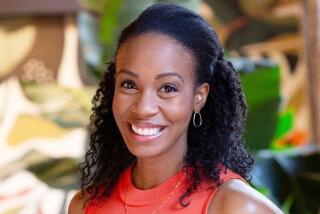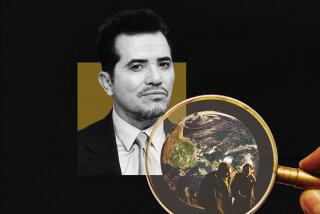Wearing a blue sanitary paper hat and...
Wearing a blue sanitary paper hat and a matching UCLA Medical Center gown, the glamorous Maria Celeste Arraras made her NBC debut on “Dateline” and in the process made herself into the most prominent player in a blossoming media experiment between two television networks in different languages. In the coming weeks she will appear on NBC as well as Telemundo, the second-largest Spanish-language TV network in the country, stirring bilingual talent into the broadcast mix.
Celeste’s perky good looks have drawn comparisons to NBC’s “Today” host Katie Couric, but her cross-network contract brings to mind the deal worked out by CNN’s foreign correspondent Christiane Amanpour, who filed special reports for “60 Minutes” on CBS.
“You have to keep reinventing yourself,” the 42-year-old broadcast journalist says during a recent visit to Los Angeles. “The public is like a boyfriend, and you have to keep doing exciting things to keep him interested.”
In April, when NBC officially acquired Telemundo, Celeste signed on as managing editor and star of “Al Rojo Vivo con Maria Celeste” (“Red Hot With Maria Celeste”), a prime-time weekday magazine show. She also agreed to report and record special segments for NBC’s prime-time evening magazine show, “Dateline.”
“Because of the NBC-Telemundo joint venture it has opened a third dimension ... where there are no rules,” she says, explaining that the cultural differences between the two networks range from the tonality of a breaking story to the amount of flashy accessories a female broadcaster is allowed to wear. On her Telemundo show, Celeste dresses more “Entertainment Tonight” than “NBC Nightly News.”
In addition to experimenting with broadcast journalists, executives are arranging inter-network “visits” by actors and actresses, and on a recent Monday, Celeste was filming a guest appearance on NBC’s daytime drama “Passions,” which features a Latino family. In the “Passions” Thanksgiving episodes, scheduled to air Friday and Monday, she plays an embellished, flirtatious version of herself.
Neither Celeste nor Telemundo executives see her guest spot on “Passions” as a threat to her credibility. Celeste even admits to having quite a bit of fun doing a sendup of herself for entertainment TV and says she doesn’t feel the least bit uncomfortable about how it might affect her role as a journalist. It’s an attitude not shared by the vast majority of reporters on English-language networks; while some take news reporter roles in feature films, it’s virtually unheard of for a broadcast news figure to appear on a soap.
Her character goes undercover and sneaks a hidden camera into the wealthy patriarch’s mansion to reveal that he is a racist. For her cameo, she was decked out in skintight brown pants with a wide belt. Her low-cut lace shirt showed off the breast implants she got nine years ago, and with a glint in her eye, she stood in front of the cameras and fed hors d’oeuvres to the graying patriarch.
In real life, Celeste is married to a Cuban-born real estate attorney, and they live with their three children in South Florida, where Telemundo is based. The area’s celebrity-crazed media culture has propelled Celeste beyond the status of a recognizable, Emmy Award-winning newscaster. She is a cover girl who was chosen this month as one of the “10 Most Intriguing People of the Year” by People en Espanol, and her every move is watched by Spanish-language entertainment press -- a critical cachet for this bilingual synergy test.
“I’m a journalist in both worlds,” she says, “but in the Hispanic world everybody follows what I do, whether it’s my kid’s baptism or what I wore to a party.”
Executives hope her well-cultivated appeal will lure some bilingual Spanish-language viewers to “Dateline,” if only on the special occasions when Celeste appears. Also as important is her ability to draw bilingual NBC viewers to Telemundo for a chance to see Celeste on her nightly magazine show.
“Al Rojo Vivo” is very popular -- the most watched show in any language in New York in its time slot. She is a household name among Spanish speakers and was all but unknown in English-only homes until she “premiered” on NBC in August with a piece on the 10-month-old Guatemalan sisters conjoined at the skull who were surgically separated at UCLA Medical Center.
“NBC and Telemundo have had exclusive access for months now,” said anchor Stone Phillips, who then mispronounced Celeste’s Spanish last name twice. (It’s Ah-RAH-ras.)
“That’s OK. I don’t mind,” Celeste says. “He took the time and called several times to try and pronounce it correctly. It showed a lot of sensitivity to the market and the Spanish-speaking audience.”
The girls’ family let Celeste spend the night in the hospital, and she was on deadline for both networks at the same time, finishing the “Dateline” segment less than one hour before it was broadcast. For Celeste, the twins story was more than just exposure to a new audience. It was a delicious opportunity to investigate what she calls “American TV” -- the “other” world that Spanish-language broadcasters have long glorified.
“We had this big myth that it would be a different ballgame -- that it would be awesome, bigger and better. But, to my surprise, it was very similar,” says Celeste, who sounded like a spy divulging intelligence from the front. “The only difference is there were more resources. You can pre-plan and take things at a more normal pace. In Spanish TV, we have less resources, so we are more aggressive. We are hungrier.”
Andy Lack, president and chief operating officer of NBC, says he was concerned her English would not be up to “prime-time standards.”
“Not only was it acceptable, it was great. It was one of the highest segments at ‘Dateline’ that quarter,” he says. “She was credible, so I didn’t think viewers were sitting around thinking, ‘Why is this Spanish-accented person doing this story?’ I think they thought, ‘This person knows the place, knows the story, and it’s important and authoritative.’ She’s a serious, smart journalist.”
Crossover appeal
Less well-known talent is being cultivated as well. Last April, Telemundo affiliate reporter Angie Sandoval filed reports for MSNBC during the attempted coup in Caracas, Venezuela. And last summer, NBC affiliate reporter Patricia Andreu, of NBC6/WTVJ in Miami, helped host a telethon on Telemundo’s Miami affiliate, Channel 51/WSCV.
Andreu has also filed breaking news stories for both stations.
“I’ve gone live on top of NBC6 newscast in English and a few minutes later, the earpiece is switched by master control and suddenly, I’m hearing Spanish, and I have to do the same thing,” she says. “In five or 10 minutes, I will have filed breaking news stories in two different languages, for two different stations. You definitely have to switch your brain to make sure you don’t try to translate word for word. You actually have to think in the different language to speak intelligibly.”
And that can be a sticking point. The correspondents must be thoroughly fluent in both languages, not just conversational. Executives at Telemundo and NBC say the key to success for the bilingual experiment is clarity and quality, so that viewing audiences never worry that information got lost in the translation.
“It is important for diction to be as perfect as possible,” says Telemundo’s President and CEO Jim McNamara, who likes to say that NBC’s $2.7-billion purchase of Telemundo will go down as the best bargain the Peacock network ever made.
That remains to be seen, but the average Latino household has more children than non-Latino families, a statistic Telemundo and Univision use to urge ad buyers to plunk down money on domestic, child-oriented products, like detergents and diapers.
“The numbers from the 2000 census that show Hispanics have strong incomes and are buying a lot of new products gave a legitimacy and credibility that no marketeer can ignore anymore,” says Maria “Liz” Castells-Heard, president/partner of Castells & Asociados, an ad firm that specializes in Spanish-language ad campaigns for clients such as McDonald’s, Toyota, AT&T; Broadband and Safeway.
What’s more, advertisers say, Spanish-speaking consumers tend to be more loyal to products and brands than non-Spanish-speakers. And in Celeste, the network already has a brand viewers like and trust.
For eight years, Celeste anchored “Primer Impacto,” an investigative newsmagazine on the Univision network, the country’s largest Spanish-language TV network. It was a platform that made Celeste famous and garnered her two book deals. After only a few years, though, Celeste was champing at the bit for more responsibility and variety, but Univision did not want to rejigger what the ratings showed was a winning format.
On the same day in April that the FCC approved NBC’s purchase of Telemundo, Celeste publicly hitched her star to Telemundo -- her former rival -- and agreed to do some stories for “Dateline.”
“What worries me is that instead of seeing it as a magnificent project that opens doors on both sides, some shortsighted people will feel threatened by it,” she says, sipping a Diet Coke and waiting for her next scene on the soap opera.
“Especially anchor people that speak only English.”
More to Read
The complete guide to home viewing
Get Screen Gab for everything about the TV shows and streaming movies everyone’s talking about.
You may occasionally receive promotional content from the Los Angeles Times.






